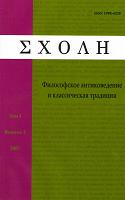Формообразующая и посредническая роль души Христа в позднем оригенизме
Form-giving and Intermediary Function of the Soul of Christ in Late Origenism
Author(s): Vladimir A. BaranovSubject(s): Christian Theology and Religion
Published by: Новосибирский государственный университет
Keywords: Origenism; Platonism; Soul of Christ; Christology; Embryology; Eucharist
Summary/Abstract: On many occasions Byzantine Iconoclasts name religious images “soulless.” The article offers a review of the pertinent sources and a re-evaluation of the Iconoclastic doctrine exploring the hypothesis that the Iconoclasts might have used the term in a literal and technical sense of “deprived of soul.” Indeed in the Iconoclastic doctrinal sources the mediating role of Christ’s soul between the divinity of the Word and the human flesh is emphatically stated. This Christological scheme, going back to the Christian Platonist Christology of Origen and his followers, preconditions the primary objection of the Iconoclasts to the veneration of artificial images: the Iconodules’ failure of rendering the soul of Christ on the icon results in confusion or separation of natures since the soul in the Iconoclastic Christology is that which holds the natures of flesh and of divinity together. Moreover, in a passage on the non-anthropomorphic Eucharist as the legitimate image of Christ, the Iconoclasts parallel the Incarnation to the Eucharist, stating that Christ assimilated only the matter from the human nature, which is not characterized by any human shape. If we add to this other passages on the Incarnation that mention the human soul of Christ, it becomes clear that the doctrine of assuming only flesh from mankind, represented by the Virgin Mary, is a consistent doctrine. In this Christology, the soul of Christ is not only pre-existent, but has a special instrumental function, condensing and shaping Christ’s body in Mary’s womb. The role of the Mother of God in this Christology is substantially less important since she only provides matter to the Christ’s soul which shapes his human body. This can explain the substantial amount of hagiographical sources that accuse the Iconoclasts of a “Nestorianizing” attitude towards the Mother of God.
Journal: ΣΧΟΛΗ. Философское антиковедение и классическая традиция
- Issue Year: VI/2012
- Issue No: 2
- Page Range: 259-282
- Page Count: 23
- Language: Russian

